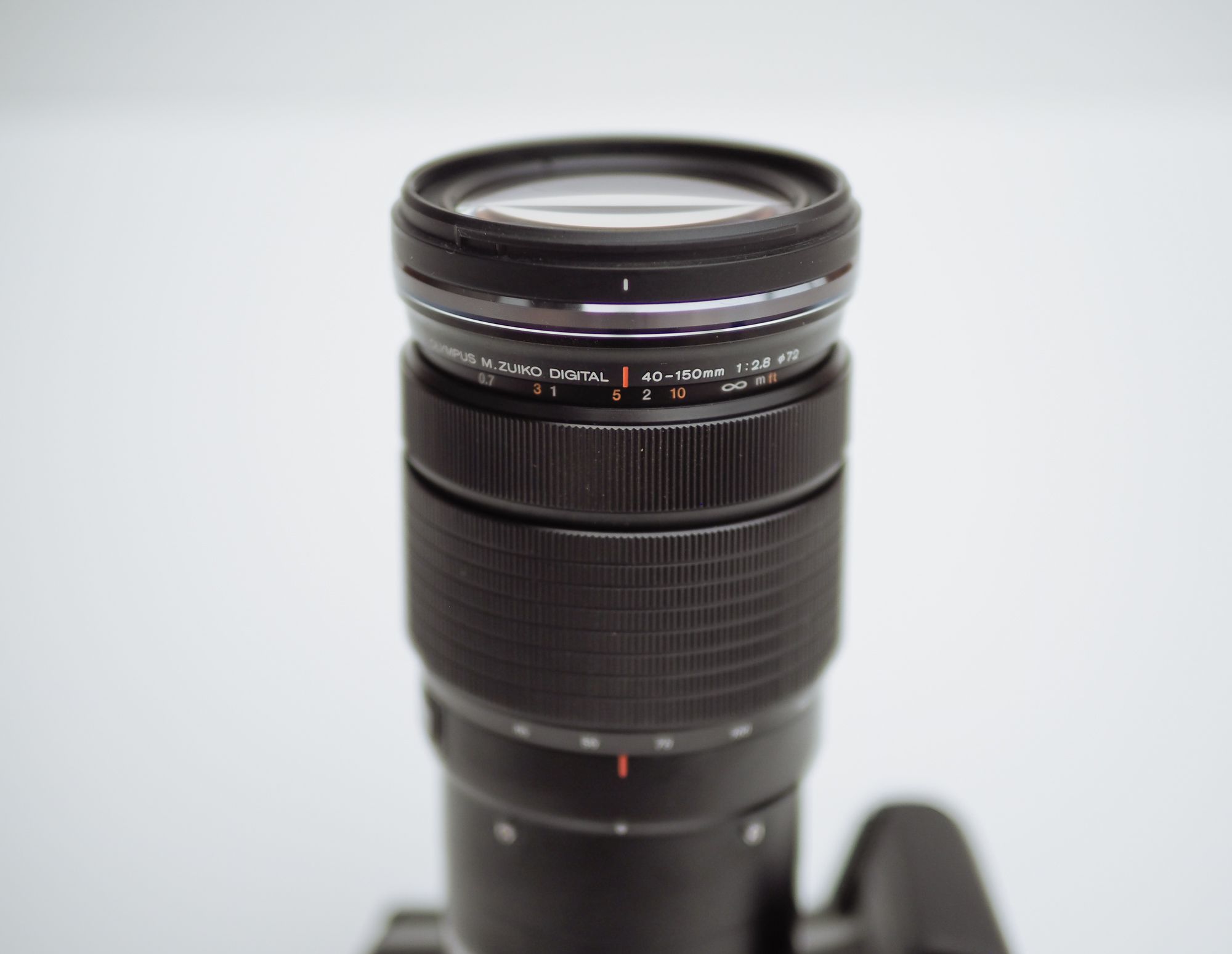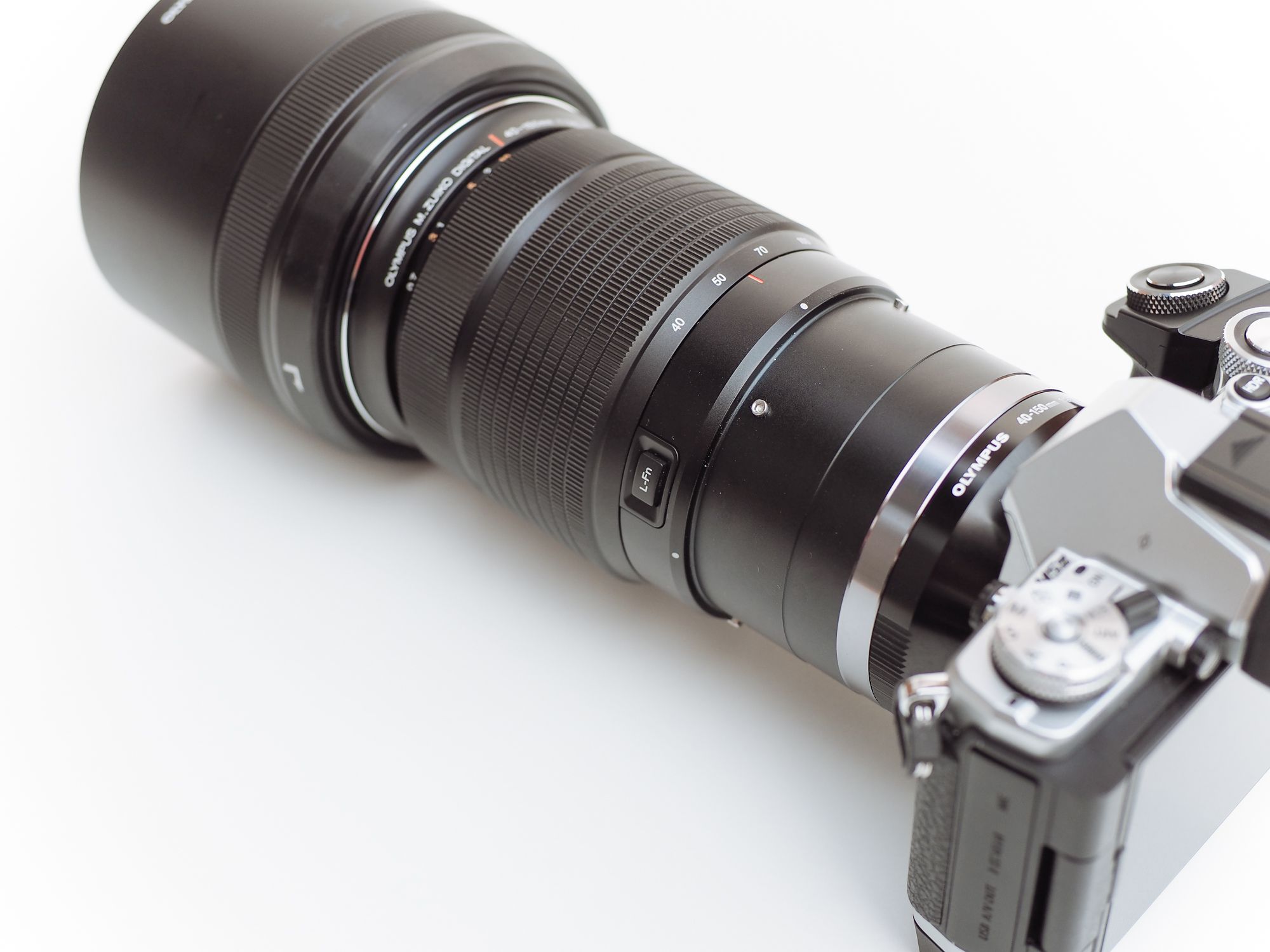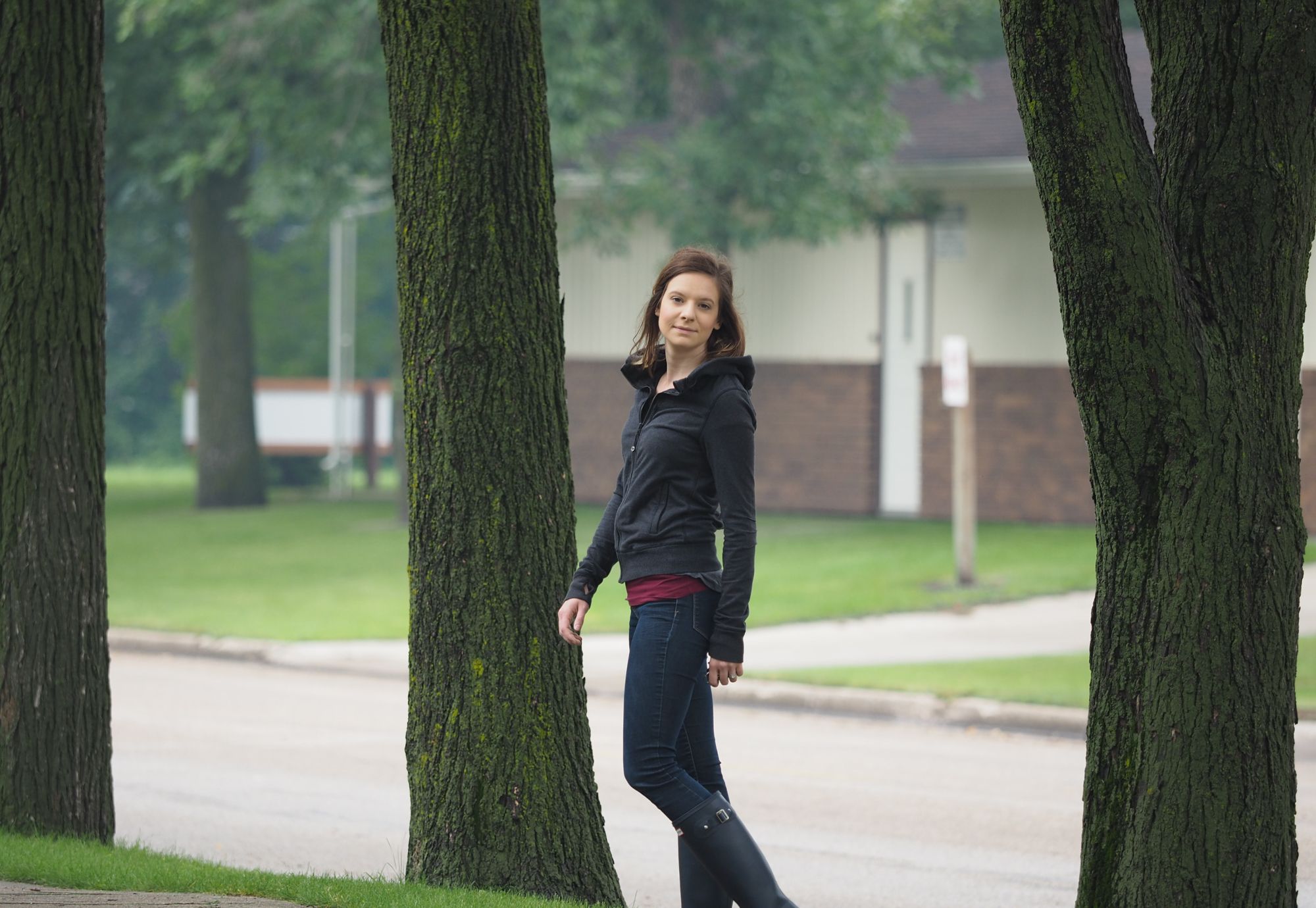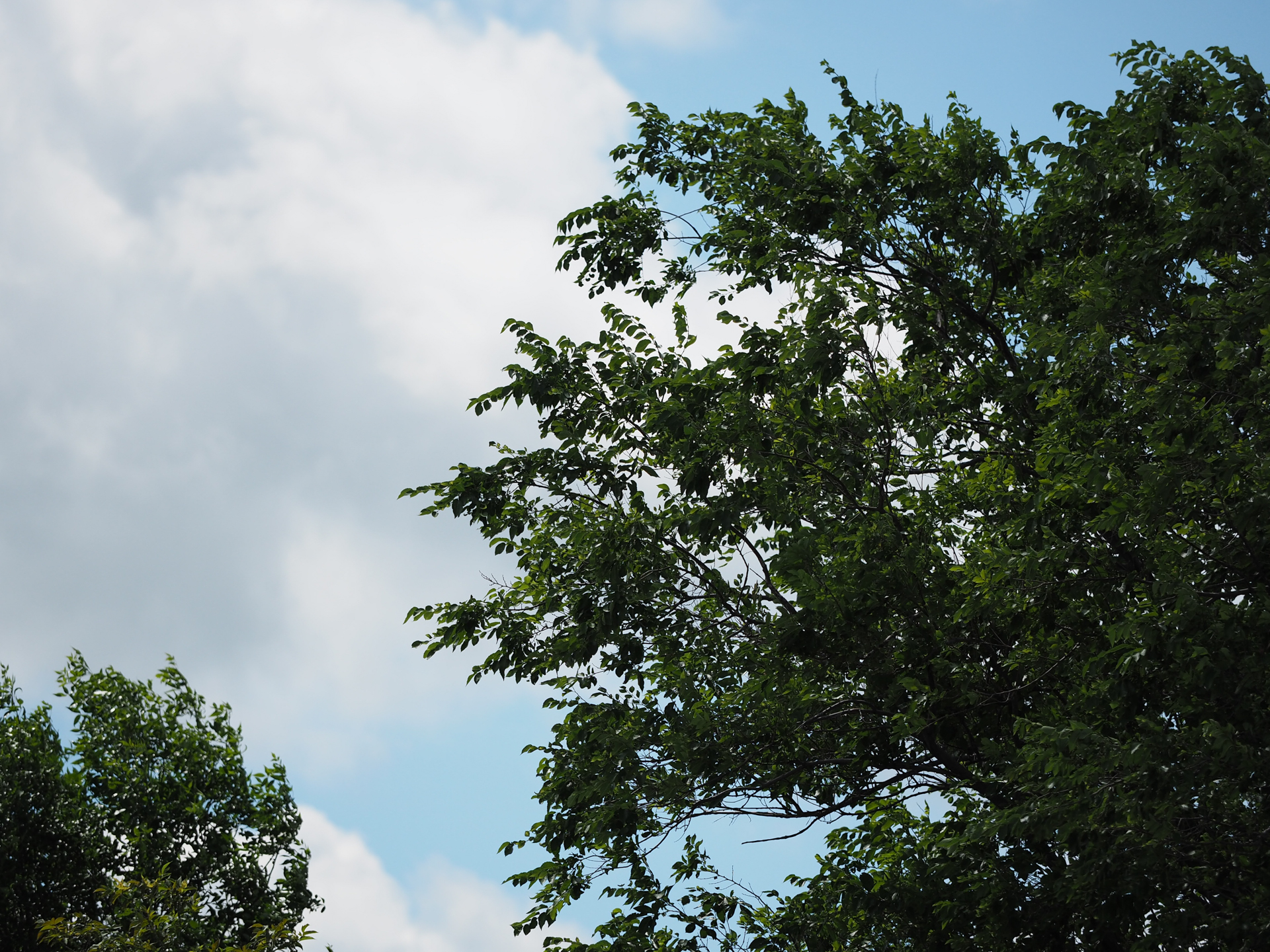This past May, my wife and I travelled to Vancouver for a long weekend and I had a chance to test out the versatility of an Olympus PRO zoom dynamic duo.

The Olympus 40-150mm f/2.8 PRO telephoto zoom lens on the Olympus OM-D E-M5 Mark II.
I set out with a sling bag filled with the Manfrotto PIXI Mini tripod, the Olympus OM-D E-M10, the Olympus 12-40mm f/2.8 PRO, and the Olympus 40-150mm f/2.8 PRO. Olympus often brags about how their small OM-D bodies and PRO zoom lenses are the best photography equipment for travellers, and our trip to Vancouver was a great chance to verify those claims.
Looking back, I don’t think Olympus is off the mark with that claim: The Olympus PRO zooms are a durable and incredibly versatile combination of lenses for those looking for top end image quality, yet substantial portability. And with the launch of the 7-14mm f/2.8 PRO, Olympus has properly rounded out the “Holy Trinity” of Micro 4/3 zooms.

The 40-150mm f/2.8 PRO is part of Olympus’ “Holy Trinity” of zoom lenses.

In comparison to the other PRO zoom lenses, the 40-150mm f/2.8 PRO is much larger, even on a camera with a substantial grip.
However, there’s always a “but” somewhere, and that “but” rests with the 40-150mm f/2.8 PRO. Olympus’ professional grade telephoto zoom lens (in Micro 4/3 talk, the 40-150mm equates to an 80-300mm lens in full frame) replicates the impeccable image quality, the durable build quality, and the wide range of extra features of the 12-40mm f/2.8 PRO, but its size makes it stand out from the rest of the Holy Trinity crowd.
Since returning from our trip, I’ve looked on my 40-150mm f/2.8 PRO lens with extreme ambivalence. On one hand, it’s my favourite lens ever. On the other, I rarely want to pull it out unless I’m ready for a dedicated shooting day. This lens isn’t your everyday carry, one handed street photography lens waiting to capture random passersby. But it is the best possible lens you can buy for controlled environments, sporting events, or for studio photography. Perhaps it’s fair to say the 40-150mm f/2.8 PRO is the first studio-type lens for the Micro 4/3 system. Within that definition, you may be able to understand where my questioning of this lens comes from.

Carrying the 40-150mm f/2.8 PRO and OM-D E-M5 Mark II at your waist is more cumbersome than a small OM-D E-M10 and pancake lens.
That doesn’t mean the 40-150mm PRO isn’t a great option for candid portraits or sporting events in your arsenal. My small hands and relatively infant photography hobby all point this lens away from me. But even the most popular photographers claim the 40-150mm PRO is one of the best telephoto lenses on the market for any system.
This lens is for someone. In fact, it’s meant for a lot of someones. But I don’t believe it’s for me in my current context. Here’s why.
Build Quality
The Olympus 40-150mm f/2.8 PRO exemplifies the very definition of build quality. From durable metals, high end plastics, and thoughtful features, I doubt there’s a better built lens in the Micro 4/3 catalogue.

Construction
Just laying your eyes on the 40-150mm PRO gives an impression of quality and durability. The lens barrel and lens mount are made of solid metal and this heavy duty metal — combined with the overall size of the lens — give the lens a substantial weight.

The large, heavy size of the lens means it can be handled with the grip seen above. Although this grip isn’t ready to quickly shoot, it’s a secure way of holding the camera when walking.
But the weight of the metal has its own positives as well. As I was shooting this review, I setup my makeshift white backdrop and attached the Olympus OM-D E-M5 Mark II and 40-150mm lens to the Manfrotto PIXI Mini tripod. I left for a few minutes and came back to find the vertical board of my white backdrop had fallen square on top of the camera/lens/mini tripod combination. The plastic tripod shattered in pieces as the heavy piece of melamine fell on top of it, but, remarkably, the lens and camera combo took the falling board like a champ. The hard metals of the 40-150mm’s zoom ring and lens body have no noticeable damage and the top of the E-M5 Mark II has the smallest mark (I had to look for it). The board has a fair weight to it, and knowing how far the board dropped onto the camera and lens only gives me the utmost confidence in the durability of the entire package.

The manual focus ring is not made of the same high quality metal found in the zoom ring, but the durable plastic holds its own.
The manual focus ring is made of a high quality plastic which feels much like the metal throughout the rest of the lens body. In fact, I was surprised to learn it was made of plastic.

The large, 72mm front element looks professional and gives a good first impression. However, the large front element also notifies your subjects you are shooting, meaning your subjects may not act as natural as if you were using a smaller, more conspicuous lens.
Like the rest of the lens, the front element is very large for the Micro 4/3 world. The 72mm front element has threads for protective filters to keep the lens in pristine condition. The nice side effect of the large front element the lens’ ability to demand attention. Small front elements, like those found on the Panasonic Leica DG Summilux 25mm f/1.4 lens, or the Panasonic Lumix 20mm pancake lens, don’t give the proper impression of the lens’ capabilities. In contrast, the 40-150mm’s front element is big, beautiful, and very professional looking.

The 40-150mm f/2.8 PRO alongside the 12-40mm f/2.8 PRO. The 40-150mm f/2.8 PRO’s internal zoom allows it to say the same size no matter the focal length. The same can not be side about the other two PRO zoom lenses.
The 40-150mm PRO zooms internally, meaning the lens doesn’t extend as you zoom in on a subject. The focus mechanism also moves internally and doesn’t spin the front element, allowing for the use of circular polarizers to cut down on glare and increase contrast and saturation. The focus ring and internal mechanism spin very smoothly and even puts the 12-40mm PRO to shame. There is a nice amount of friction in the zoom ring and the entire zoom ring has a premium feel. The small notches in the zoom ring give a tactile feel while zooming and the notches are durable to boot.
Manual Focus Clutch
Like the Olympus 12-40mm f/2.8 PRO, the new 7-14mm f/2.8 PRO, the Olympus 12mm f/2.0, and the Olympus 17mm f/1.8, the 40-150mm PRO utilizes a unique manual focus clutch system to flip between autofocus and manual focus in a pinch.

The focus ring can be pulled back to snap the camera into manual focus mode. This is one of the most efficient ways to quickly find a precise focus point.

Pulling back the focus ring reveals a focus distance scale, but no depth of field scale.
Pulling the manual focus ring back towards the camera reveals a focus scale and instantly snaps the camera into manual focus mode. The focus ring spins very smoothly and stops at hard stops on both ends. I’m a big fan of hard stops on focus rings, if only for knowing exactly where I’m focused at any given time. Having said that, the overall depth of field and focal length of the 40-150mm give a wide range of focus possibilities, so precisely focusing at the 150mm focal length and at infinity can be extremely touchy.

When pulled back, you can program your camera body to instantly turn on manual focus assisting features like focus peaking and magnification. I’m a big fan of focus peaking and it tips the focus scales towards the manual end of the spectrum for me.
The manual focus ring is a focus by wire system, just like the rest of Olympus’ PRO zooms. Even still, the ring feels of premium quality and, aside from precision at the infinity end of the focus range, provides a great manual focus experience.
Weather Proofing
Like the other PRO zooms, the 40-150mm PRO is weather sealed and can fend off dust, freezing, and random splashes of water. I’ve never once hesitated to take this lens out into a light rain, but I’d be a bit hesitant to head outside in a downpour. However, in order to be truly weather sealed, you need to be shooting with a weather sealed body as well. If you’re out shooting the 40-150mm PRO with any PEN camera or the OM-D E-M10, the weather sealing of the lens is moot.
Accessories, Lens Hood, Tripod Collar, and A Small Bit on the MC-14 Teleconverter
Olympus has been known for making accessories only available for purchase on top of the lens purchase. When compared to lens manufacturers like Panasonic, this is a total letdown. In the past, Olympus has withheld a lens hood or carrying case from the original packaging. When paying hundreds of dollars for a lens, these types of accessories seem like a no-brainer to include.

The innovative lens hood is made of heavy duty plastic and can easily handle the lens and camera body’s weight.
Since the release of the 12-40mm f/2.8 PRO, Olympus has started to include these accessories in all their PRO lens packages. Like the 12-40mm f/2.8 PRO, the 40-150mm PRO comes with a large carrying bag, a very nifty lens hood, and a tripod collar right out of the bag.

The heavy duty plastic is a great way to protect the front element of the 40-150mm f/2.8 PRO. I had an accidental mishap where the lens hood took the brunt of the damage. Had I not had the lens hood attached, the front of my 40-150mm f/2.8 PRO would be severely damaged. And even after the mishap, the lens hood is still in fantastic shape.
The 40-150mm PRO’s lens hood is a stroke of genius. You attach the lens hood to the front of the lens like any other lens. But spin it slightly further and you can retract the lens hood right over top of the body. This allows the lens to take up less space in your bag and encourages you to keep the lens hood attached at all times.
The lens hood is made of a high quality plastic, which helps keep the hood lighter in weight. The plastic lens hood is great for protecting the lens from random bumps and dings as well. My story above regarding the smashed tripod would have resulted in a smashed front element if not for the lens hood attached to the lens.

When extended, the 40-150mm f/2.8 PRO’s lens hood greatly increases the overall size of the lens package.

Spin the lens hood slightly to the left and the hood retracts to minimize the space it takes up in your bag.
The lens hood makes the entire 40-150mm PRO package look quite large. The lens hood extends the package about 30% to 40% beyond the front element, giving the illusion the lens is substantially bigger than it actually is.

A quick size comparison of the 12-40mm f/2.8 PRO and 40-150mm f/2.8 PRO with both lens hoods extended.

The 40-150mm f/2.8 PRO is much larger than the Panasonic Leica Summilux 25mm f/1.4 lens, even with the Leica’s lens hood attached.

However, with the lens hoods retracted and ready for storage, the 40-150mm f/2.8 PRO minimizes its size and doesn’t look as large as its fully extended position.
I tend to use the lens hood as often as possible when outdoors in direct sunlight due to lens flare (we’ll touch on this more later), but I generally tend to leave the lens hood unattached. Despite the clever lens hood retraction, I’m just not a fan of lens hoods in general. The 40-150mm PRO’s lens hood is big and obtrusive, and makes people aware you are shooting a photograph with a higher end set of equipment. Take the lens hood off, and you’re left with a smaller lens, more inconspicuous lens which people may shrug off and continue to act normally around.
Also included in the 40-150mm PRO package is an all-metal tripod collar. The tripod collar attaches directly to your tripod mount and evens out the weight of the lens for improved stability. Attaching and unattaching the tripod collar is a breeze: loosen the collar slightly via the heavy duty screw and spin the collar 180 degrees before pulling it off. Unfortunately, you’ll have to unmount the lens from your camera body in order to take the collar off as it has to slide off towards the base of the lens.

The all metal tripod collar is solidly made, but I prefer to leave the collar off for ergonomic purposes.
I can’t say much more about the tripod collar than that. I don’t shoot with a tripod very often, so I choose to unattach the collar and store it in my bag for those rare times I need it. The tripod collar gets in the way when gripping the lens and it also makes the camera more difficult to store in my bag when attached. So with that in mind, I’m grateful the tripod collar can be removed and added when needed.

Oddly, the 40-150mm f/2.8 PRO’s bag is made of a different material than the smaller 12-40mm f/2.8 PRO. I prefer the 12-40mm bag’s material.
Lastly, the 40-150mm PRO comes with a large carrying bag to keep it scratch free while stored. The bag is made of a different material than the 12-40mm PRO carrying bag however, which I find a bit odd. The bag is made of a canvas material instead of the 12-40mm PRO’s soft, plush material. In terms of durability, the 40-150mm PRO’s bag will be a step ahead of the 12-40mm PRO’s bag solely because of the durable canvas material. In my opinion though, it seems odd to not be consistent in carrying bag materials for all PRO lenses across the board.
The bottom of the 40-150mm PRO’s carrying bag has a synthetic leather, so you won’t damage the bag or the lens inside if you set the bag on a damp spot.

A thoughtful addition to the 40-150mm f/2.8 PRO’s bag is the loop to hold the MC-14 Teleconverter carrying pouch. The teleconverter multiplies the focal length by a factor of 1.4 and is made specifically for the 40-150mm f/2.8 PRO and the upcoming 300mm f/4.0 PRO.
A handy inclusion on the 40-150mm PRO’s bag is a small loop to attach the carrying bag of the MC-14 Teleconverter. The MC-14 Teleconverter comes in a small pouch and this pouch adheres nicely to the side of the 40-150mm PRO bag for safekeeping.
The MC-14 Teleconverter can be attached between the camera body and the lens and increases the focal range of the 40-150mm PRO by 1.4 times. It also decreases the lens’ overall aperture to f/4.0 instead of f/2.8, but this is common with lengthy telephoto lenses in the 400mm range. With the teleconverter attached, the 40-150mm f/2.8 PRO essentially becomes a 56-210mm f/4 PRO lens. In full frame terms, this gives an effective focal length of 112mm to 420mm. So, in theory then, you can own the 12-40mm f/2.8 PRO, the 40-150mm f/2.8 PRO, and the MC-14 Teleconverter, and cover a range of 24mm to 420mm with only three pieces of gear.
Unfortunately though, I have not yet purchased the MC-14 Teleconverter for testing. It’s a $349 accessory which essentially gives you an entirely new lens in the 40-150mm PRO and will also work with the future release of the Olympus 300mm f/4 PRO. From tests I’ve read across the web, the teleconverter doesn’t hinder sharpness (a common problem of teleconverters across the board) and instead allows the lenses to reach the required focal lengths for bird and wildlife photography. If these are the types of photography you’re aiming to get into, the MC-14 Teleconverter may be right up your alley.
Ergonomics
Writing an ergonomics section about the 40-150mm PRO is a bit of a mixed bag. With two hands, the 40-150mm PRO is a dream to use. In contrast, with one hand, there’s very little chance of comfortably shooting photographs with this lens. The 40-150mm PRO demands a third party grip for both the E-M10 and E-M5 Mark II, and even then still remains a bit clumsy when attached to the E-M10. Like the rest of the lens’ overall characteristics, the ergonomics of the lens are polarizing.

The 40-150mm f/2.8 PRO was made to be used with a two handed approach and with an OM-D camera with an extra grip.

The 40-150mm f/2.8 PRO can be used with the smaller E-M10 and in portrait modes, but it’s not as comfortable as other lenses I’ve tried.
No matter the camera body you’re using, the 40-150mm PRO demands a two handed approach to shooting. The large zoom ring and relatively large focus ring are just the right size to provide an excellent feeling when using two hands. With your left hand positioned underneath the lens, you can quickly zoom in to your target and focus quickly by pulling the manual focus clutch back with your index fingertip. The lens function button is also positioned perfectly to be used with your left thumb. Changing settings is very quick and rarely demands the need to pull the camera away from your eye in the viewfinder. And the lens package as a whole has enough weight to feel sturdy and stout in your hands. Every feature of the 40-150mm PRO has been positioned precisely for a two handed approach, and when shooting with two hands, this lens is a dream.

Everything on the 40-150mm f/2.8 PRO has been positioned to be quickly accessible with your left hand. The zoom rings are perfectly positioned to be operated simultaneously and the lens function button is perfectly placed for your left thumb.
Take your left hand away from the camera though, and you’ll hate the lens. The lens is almost too heavy to be properly controlled with only one hand on the camera body, and many of the extra features (like the lens function button and the manual focus clutch) are lost when shooting with one hand.
So why even bring a one handed shooting approach up? Because many, many people assume the Micro 4/3 system is meant for quick, one handed snapshots. All the camera bodies are tiny in comparison to larger full frame cameras, and the system’s lenses are minuscule to other systems as well. As a result, the Micro 4/3 system in general is known for its impressive point and shoot style images.
The 40-150mm PRO lens will not fall into this style. This lens is meant to be used with two hands and held with your eye in the viewfinder. If you often find yourself shooting photographs with the camera held away from your body, the 40-150mm PRO will quickly change your habits.
Once the two handed approach to holding this lens is used, there are still other factors to remember. Olympus’ OM-D line has different sized camera bodies with different sized grips. The less expensive OM-D E-M10 has majorly different ergonomics with the 40-150mm PRO than its more expensive OM-D brothers. Here are a couple quick looks at the ergonomics of the 40-150mm PRO attached to the smaller E-M10 and the new E-M5 Mark II.
With OM-D E-M10
The OM-D E-M10 is the smallest and lightest of Olympus’ OM-D camera bodies, so it naturally has more difficulties adjusting to the relative size of the 40-150mm PRO. Without the added front grip, I’d be very wary of taking the 40-150mm PRO lens out of my bag.

The OM-D E-M10 demands an extra grip to more comfortably use the 40-150mm f/2.8 PRO. Even with the extra grip, holding the camera and lens combo is not ideal.
The extra front grip provides enough of a grip area to hold the the camera/lens combo, but bringing the camera up to your eye with only one hand and the extra grip is uncomfortable. Even when carrying the camera/lens at your side, the 40-150mm PRO demands more stability in the front grip of the camera.

Overall, although it’s not impossible to properly use the 40-150mm PRO with the OM-D E-M10, I recommend the E-M5 Mark II with added grip or the larger OM-D E-M1. The 40-150mm PRO doesn’t seem like it was made to be used with the E-M10, even though it can be used if necessary.
With OM-D E-M5 Mark II
The OM-D E-M5 Mark II retains much the same size as the prior OM-D E-M5 and the less expensive OM-D E-M10. Although it has the same height and width as those other cameras, the E-M5 Mark II is a bit deeper and has a larger, more protruding front grip. The added depth of the camera body helps the overall shooting experience when shooting with the 40-150mm PRO.

The E-M5 Mark II has a more substantial after market grip and this gives a much more comfortable experience when using the 40-150mm f/2.8 PRO.
Yet, even the deeper, more protruding grip isn’t enough to provide the kind of stability I was looking for with the 40-150mm PRO. I made sure to purchase the extra grip for the E-M5 Mark II as well, and this grip provides more of the comfort I was looking for when using the 40-150mm PRO. The added grip protrudes much further from the body than the extra grip for the E-M10, helping give better stability when carrying the camera/lens at your side and when bringing it up to your eye to shoot.
The E-M5 Mark II’s added grip also comes with a vertical grip option to be attached to the bottom of the camera. This gives even better support when shooting portrait photos with the large 40-150mm PRO. I haven’t purchases the vertical grip as I haven’t found the ergonomical need to, but if I was shooting portraits professionally, I’d be sure to purchase the vertical grip as well.

As mentioned, the ideal way to hold and use the 40-150mm f/2.8 PRO is with an E-M5 Mark II and attached grip or with an OM-D E-M1 and with your left hand properly holding the underside of the lens.
The 40-150mm PRO was made to be used with Olympus’ more expensive OM-D bodies. With the added front grip, the E-M5 Mark II and 40-150mm PRO are an excellent combination for heading outdoors and shooting photos of wildlife or sports. The experience is far better than the E-M10 with added grip, to the point that I no longer use the 40-150mm PRO with the E-M10.
Autofocus
I’m not sure how to say it any other way: The Olympus 40-150mm f/2.8 PRO has blazing fast, super quiet autofocus. The lens’ autofocus speed is almost unparalleled. It’s the first thing people notice when I show off the lens and it’s the last thing people talk about when they put it down. Olympus has found a way to achieve extreme autofocus performance in their PRO zooms and the 40-150mm PRO is no different.

In addition to lightning quick focus speeds, the 40-150mm f/2.8 PRO can focus a mere 27.5″ from the front element. Combine this close focusing distance and the 150mm focal length and you’ve got yourself a half-decent macro lens for close up shots.
When outdoors and in good light, the 40-150mm PRO find its focus target quickly and silently. When indoors, the 40-150mm PRO has to work a bit harder to find its target. Luckily, the lens’ speed allows it to bounce from one focus location to the next incredibly quickly and it mitigates focus hunting in low light.
Also like the 12-40mm PRO, the 40-150mm PRO sports Olympus’ MSC (Movie-Still-Compatible) Linear Motor Drive System for quiet autofocus. This helps the camera capture more pure sound and less of the lens’ autofocus system zipping from one place to the next.
Image Quality
As big and as expensive as the 40-150mm PRO is, you’re right to expect top level image quality. Aside from some slightly distracting bokeh and some lens flare when in direct sunlight, the 40-150mm PRO delivers exceptionally sharp results with a neutral colour rendering and very little vignetting.
Sharpness
Olympus’ top end lenses, like the 75mm f/1.8 and all the PRO zooms, are known for their high level sharpness right from wide open. The 40-150mm PRO continues this trend and offers great sharpness from f/2.8 and at every focal length between 40mm and 150mm.

An image of a water fountain shot with the 40-150mm f2/.8 PRO.

The same image as above but in a 1:1 crop factor. The 40-150mm f/2.8 PRO has superb sharpness across the from at all focal lengths.
With that out of the way, I’ll admit the lens’ sharpness quality is beyond my recognition. I’ve never been a stickler for extreme sharpness, so my ability to test the 40-150mm PRO’s sharpness is poor. One of my favourite lens review websites, ePhotozine, has reviewed the 40-150mm PRO and has the following to say about the lens’ sharpness:
At 40mm sharpness is already outstanding in the centre of the frame at maximum aperture, although performance towards the edges falls behind somewhat, only reaching fairly good levels. Stopping down improves performance across the frame, with peak sharpness across the frame being achieved at f/5.6. Here clarity is outstanding in the centre, and very good towards the edges.
Zooming to 70mm results in a reduction in sharpness in the centre at maximum aperture to excellent levels, although performance towards the edges is improved to very good levels of clarity. Peak performance across the frame is achieved at f/5.6 where sharpness is excellent in the centre and falls just short of this towards the edges.
Finally, at 150mm sharpness drops to very good levels in the centre of the frame at maximum aperture and clarity towards the edges of the frame drops just below good levels. When stopped down, performance across the frame improves, with excellent levels of clarity being achieved between f/5.6 and f/8 across the frame.
This perfectly sums up the 40-150mm PRO’s sharpness and ePhotozine has done a bang up job in their specifics. You can also visit ePhotozine to view other sharpness charts if you are looking for exact numbers.
Overall, the 40-150mm PRO won’t be the softest lens in your arsenal and is sure to deliver detailed results wherever you are in your focal range and at whichever aperture you choose to shoot with.
Bokeh and Depth of Field
As the 40-150mm PRO covers many of the standard portrait focal lengths, bokeh and creamy blurred backgrounds are an essential. While I’m happy to report the 40-150mm PRO has creamy, smooth backgrounds, the backgrounds as a whole are slightly distracting.
The lens is loaded with nine aperture blades which help to produce circular bokeh balls. However, as you can see in the following image, bokeh balls have a bit of a cat eye shape towards the edge of the frame.

The bokeh is fairly smooth in this image of a squirrel, but the bokeh balls become a cat eye shape at the edges of the frame.
The bokeh in the image of the squirrel, in my opinion, is fairly distracting and the cat eye shaped bokeh balls are not an ideal shape. However, the background as a whole is creamy and free of haze.

As seen to the right, the 40-150mm f/2.8 PRO’s fair sized aperture provides a good depth of field to work with.
Depth of field is on par with a Micro 4/3 sensor and an f/2.8 aperture. In the above photograph, you can see the in focus and out of focus regions when the 40-150mm PRO was opened up to f/2.8. F/2.8 on a Micro 4/3 camera can also be multiplied by the 2x crop factor to find the rough equivalent on a full frame camera. With that, the f/2.8 aperture is roughly equivalent to an f/f.6 aperture on a full frame camera. So, while you can still achieve good depth of field control and better depth of field than any other Micro 4/3 lens, the 40-150mm PRO will fall short of f/2.8 lenses in a full frame format.
Colour Rendition and Contrast
Just like the 12-40mm f/2.8 PRO — and any Olympus lens for that matter — the 40-150mm PRO renders images with a neutral, sterile tone.

Like all Olympus lenses, the 40-150mm f/2.8 PRO’s colour rendering is more neutral than other lenses, especially the Panasonic Leica branded lenses.
Colours are slightly flatter and contrast is a bit higher than Panasonic’s Leica branded lenses. As we have noted in past reviews though, colour rendition can easily be changed in post processing and isn’t often the deciding factor in a lens purchase.
Chromatic Aberration and Fringing

I worked hard to find colour fringing around high contrast edges, but the 40-150mm f/2.8 PRO handles any sort of fringing with ease.
Chromatic aberration and colour fringing refer to the lens’ ability to capture a full range of colours of visible light at the same point. Heavy chromatic aberration results can result in colour fringing in high contrast points and can give purple outlines around objects in the image.
I tried hard to find colour fringing in the 40-150mm PRO’s images. I snapped photos with high contrast or directly into the sun and I was hard pressed to find noticeable fringing. Even if you’re able to find fringing when shooting with this lens, it’s super easy to correct in post processing.
Flare

The 40-150mm f/2.8 PRO handles flare fairly well, although purple flaring can be seen when shot directly into the sun or with a sun behind your subject.
Shooting directly into the sun offers difficulties for many lenses, and this is one area where the 40-150mm PRO isn’t perfect. Even with the lens hood attached, lens flare can be seen in the clouds in front of the sun in the image above.
Once again though, flare is well controlled. The image sample above was shot directly into the sun on a scorching hot day with a shutter speed of 1/16000. I doubt many people put their lenses to the ultimate test on a daily basis like this, and I also doubt flare will be an issue that can’t be corrected later on.
Real World Usage
With all the specifications and features out of the way, nailing down where and how the 40-150mm PRO excels is a bit easier.
The 40mm to 75mm focal length is ideal for medium range portraiture and still life photography. The 40-150mm PRO’s sharpness and depth of field (especially at the 75mm to 100mm mark) are great for taking shots of objects around the house, for taking photographs of young children, or for capturing those precious wedding moments. With the size and overall perception of the lens, however, people will know you are shooting photographs and may not act as naturally as they would with a less conspicuous lens.
Spin the zoom ring further and you can easily find how the 40-150mm PRO excels with action and sports photography. The 150mm focal length (300mm full frame equivalent) is a lengthy lens and allows you to get yourself right on top of the action in a baseball game or a football game. The longest focal lengths also generate the lens’ best bokeh, meaning long range portraiture is also a strong suit.
But, all this is only possible if you’re willing to deal with the 40-150mm PRO’s size and ergonomics. Rarely would I recommend bringing the 40-150mm PRO along for a random shooting evening or where photography isn’t the main point of the trip. This lens isn’t suited as a secondary, “bring it along” kind of lens. Instead, the 40-150mm PRO is meant for professional portraiture where the shooting assignment is your primary goal.
Image Samples
Here are a few extra images showcasing the 40-150mm PRO’s capabilities.







Conclusion
Now that everything is on the table, I have to be 100% honest as a writer: I don’t believe I’ll be keeping the 40-150mm f/2.8 PRO lens in my arsenal forever. I’ve spent a busy few months with the lens and used the lens in the manner in which I believe it was created for. I’ve travelled with the lens. I’ve used the lens for product photography, portrait photography, and sports photography. I’ve even used the lens for some landscape photography from time to time. And in every circumstance, the lens is so much fun to use. In fact, I’d say the 40-150mm PRO is the best lens I’ve ever used on any system.

Despite the incredible capabilities of the 40-150mm f/2.8 PRO, I don’t see this lens staying in my long-term lens arsenal. If size isn’t an issue, however, the 40-150mm f/2.8 PRO is probably one of the best telephoto zooms lenses ever made.
Where it stumbles in my photography hobby is its size. The lens’ size makes it cumbersome to carry along for long periods of time where photography isn’t the end goal and it takes up lots of room in a bag where space is of the essence.
It irks me to have to be honest like this, because this lens is seriously fantastic. Many major photographers online have proclaimed this lens’ strengths, to the point where the 40-150mm PRO is considered one of the best telephoto lenses of any system. Its build quality, feature set, image quality, and ease of use are all the best you can get in the Micro 4/3 system and put every other telephoto zoom to shame. I can’t reiterate the 40-150mm PRO’s strengths enough.

For me though, it’s just too big for my end goal. Candid portraiture and fun street snapshots are where I want to go as a photographer, and the 40-150mm PRO’s size hinders its chances of being in my long term arsenal. It’s a classic case of “It’s not the lens. It’s me.”

People who need a lens like the 40-150mm f/2.8 PRO will know who they are. When attached to an OM-D camera like the OM-D E-M5 Mark II, the 40-150mm f/2.8 PRO is an unparalleled tool in the Micro 4/3 world and offers professional level image quality in an incredibly durable package.
Alongside the 7-14mm f/2.8 PRO and the 12-40mm f/2.8 PRO, the 40-150mm f/2.8 PRO marks another fantastic addition to the Olympus PRO zoom line. These three zooms make up the best “Holy Trinity” lens lineup for Micro 4/3 shooters and cover nearly every focal length needed, especially if an MC-14 Teleconverter is included. For photographers looking for the smallest lens collection, at least in terms of number of lenses, this Olympus Holy Trinity is the place to look.